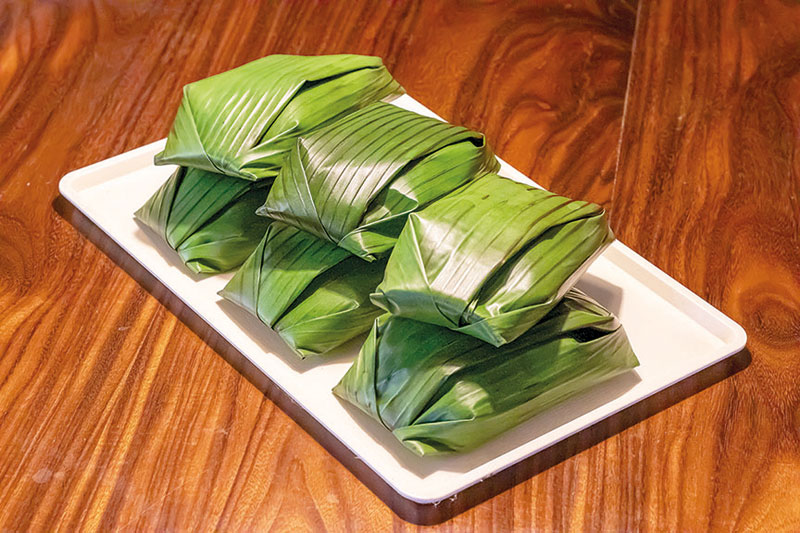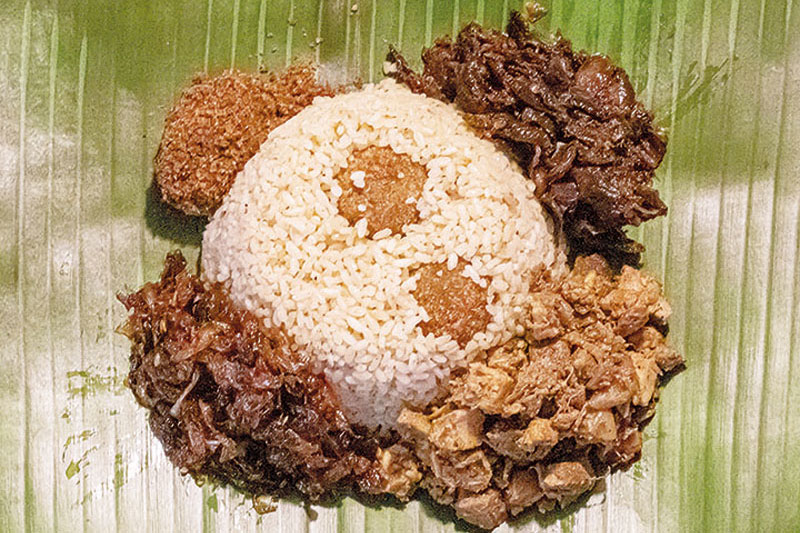

Photographs: Siyath Gowin Plus
Lamprais is a much revered culinary offering which is loved by Sri Lankans all over the world. The fragrant aroma which arouses our sense of smell when the banana leaves are unwrapped is second to none. It is often said that you eat with your eyes, but in the case of Lamprais, it is the reverse as the aroma of this perfectly packed meal of rice, mixed meat curry and condiments makes your mouth water. Lamprais is a legacy gifted to Sri Lanka by her Dutch colonisers. It is also influenced by Indonesian seafarers who landed on our shores many centuries ago. In the Netherlands, the Dutch enjoy a very similar dish named Lomprijst while in Indonesia, Java to be precise, they call it Lemper.
Staunch culinary historians may argue that when the Javanese introduced the Lemper to the Sri Lankan culinary lexicon, the Dutch elevated it by adding curries and condiments which were full of flavour and spice. The Javanese can lay claim to the prawn blachhan or belacan, a pungent paste of fermented dried shrimps mixed with salt and chilies and served in a tiny ball the size of a largish marble. The crispy frikkadels, Ping-Pong ball shaped orbs filled with a savoury minced beef/pork filling and coated in breadcrumbs pays testament to its European roots thus helping to intertwine eastern and western influences to create the Lamprais.
In decades gone by members of the Burgher community, descendants of the Dutch were the custodians of the Lamprais. Almost every Burgher woman (and some men) worth their salt knew how to make Lamprais. They took great pride in painstakingly making this culinary offering which they considered their national dish. It was part of their identity and heritage. It was something they were proud of and staunchly guarded.
The original Lamprais consisted of a small parcel of shortgrain rice such as keeri samba cooked in a meat stock served with two meat frikkadels, prawn blachan, a mixed meat curry made with diced chicken, mutton pork/beef, brinjal moju, a concoction of deep-fried brinjals cooked with spices and a dash of vinegar, seenisambol, a moorish preparation of caramalised onions infused with spices. Some preparations also include deep-fried cubes of ash plantain cooked in a thick coconut gravy. The parcel would then be carefully wrapped in a banana leaf and steamed before serving.
Whilst many reminisce fondly of the halcyon days where authentic packs of Lamprais were commonplace, in today’s culinary landscape what is offered as Lamprais in my view is a glorified rice packet. Worse still, the spelling of this iconic offering ranges from Lumprice to Lamprice and Limprice to Lumpraise!
A huge bugbear with me is that if they can not spell the dish how can they cook it to maintain its authenticity? This is not only unique to Sri Lanka. Even amongst the Diaspora, Lamprais is flogged as Lumprice and instead of an authentic Lamprais, one finds large chunks of bone in chicken, egg, fish cutlets and dare I say it even coconut sambol and in some instances a cashew curry!
Home cooks on social media are brazen enough to claim they serve authentic Lamprais “as they know it” and parcel up a huge portion of rice with lentils, beans, aubergine and many other curries. A far cry indeed from the authentic Lamprais. The Burgher ladies of yore would be aghast if they saw what is now being passed off as Lamprais.
Growing up as a child, it was a treat to tuck in to the most delicious Lamprais made by Ranee Fernando, the wife of the celebrated auctioneer Winston Fernando who lived in Havelock Town. The parcels of Lamprais were small and each one was expected to eat no more than two packs. Although I could have managed a third, the stern look from my grandfather meant that I too had to limit myself to two packs like all the rest of them.
Today it rankles me to the core to see rice packets being passed off as Lamprais. These irresponsible cooks not only in Sri Lanka but also in the Diaspora who pass off a cheap imitation of the authentic Lamprais in my mind are guilty of bastardising the Lamprais.
Lorraine Bartholomeusz, a Dutch Burgher who makes the authentic Lamprais and used to supply it to the VOC café run by the Dutch Burgher Union explains it succinctly when she says “The recipe has been easy to misinterpret because people don’t know what genuine Lamprais tastes like,” she said. “Anything goes as long as it comes wrapped in a banana leaf.”
Defenders of the bastardised version opine that because pork and beef, two ingredients in the authentic Lamprais are shunned by some communities in Sri Lanka for religious reasons, it is okay to include new variants such as chicken, fish and even a vegetarian option and pass it off as a Lamprais.
Yes, we all agree that the question of authenticity is a complex one. No dish can remain unchanged over the years. However totally changing the ingredients and calling it a Lamprais is sacrilegious! Bartholomeusz says it beautifully when she concludes “There is only one specific way of making a traditional Lamprais.
If any of those ingredients are not suitable to you, then you have to make do without eating the dish. You can’t have versions of it, because then you adulterate it.”
As an ardent fan of the authentic Lamprais, my greatest fear is that in the next few years our progeny will not know what an authentic Lamprais is and with that we will lose one of our greatest culinary offerings.